Understanding Calmer Corn Head Parts for Harvest Efficiency

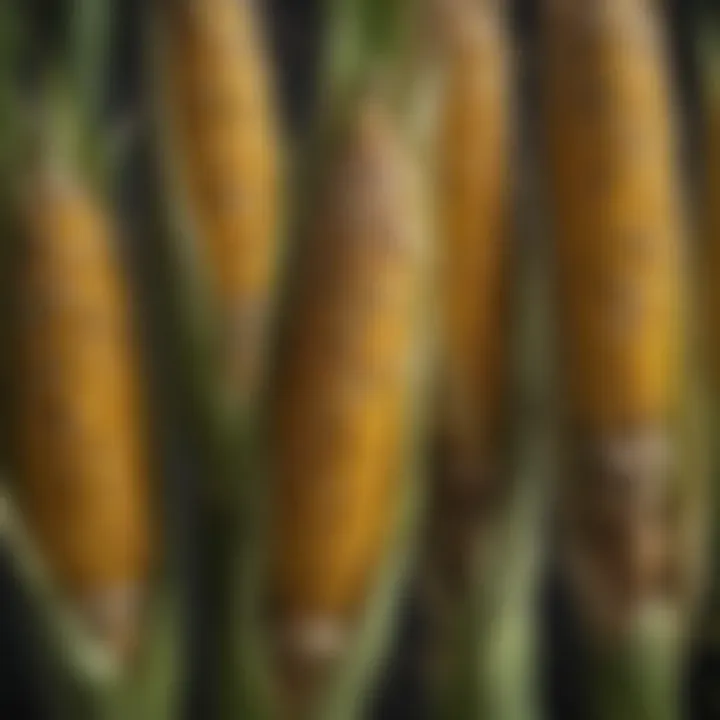
Topic Overview
Definition and Importance
Calmer corn heads are crucial implements in modern agriculture, specifically tailored for the efficient harvesting of corn. These parts are designed to enhance the gathering and processing capabilities during the harvest period. The efficiency they provide can significantly influence the yield and overall profit of corn production. Each component within a Calmer corn head works in harmony to ensure that every stalk is cut and gathered effectively, reducing waste and labor costs. For farmers, understanding these components is vital for selecting the right equipment.
Brief History and Evolution
Over the years, the design of corn heads has evolved significantly. Earlier models were often inefficient, leading to substantial losses during harvest. With advancements in technology, manufacturers like Calmer Manufacturing have pioneered innovative designs that improve performance. The introduction of features such as the Calmer Residue Management System has transformed how corn is harvested. This evolution aims to meet the growing demand for more productive and sustainable farming practices.
Key Techniques and Innovations
Sustainable Farming Practices
Sustainability in farming is increasingly important. Using Calmer corn head parts allows farmers to minimize soil disturbance and maximize crop residue management. This not only helps in maintaining soil health but also promotes better water retention and reduces erosion. The design allows for a more uniform cut, which contributes to the efficient breakdown of plant materials into the soil.
Advanced Agronomic Technologies
Modern corn heads incorporate advanced technologies. Precision agriculture tools, such as GPS and sensors, enable farmers to monitor their harvesting in real-time. These tools can help fine-tune the performance of the Calmer corn heads for optimal operation. By leveraging these technologies, farmers can achieve higher productivity while decreasing inputs like fuel and labor.
Practical Applications
Step-by-Step Guides
Using Calmer corn heads effectively requires knowledge of their proper operation. Here’s a simple guide:
- Preparation: Ensure that the corn head is compatible with your combine and that all components are in good condition.
- Adjustment: Set the header height and angle according to the field conditions.
- Operation: Engage the header while maintaining appropriate speed. Monitor performance through the combine's interface to adjust settings as necessary.
- Maintenance: Regularly check and maintain blades and gathering chains to ensure optimal performance.
Case Studies or Real-World Examples
Farmers who have implemented Calmer corn heads report notable improvements in efficiency. For instance, a case study from a Missouri farm showed that utilizing these parts reduced harvesting time by 15%, thus allowing for the possibility to manage larger fields without extra labor. Improvements in residue management also enhanced the soil for subsequent planting seasons.
Understanding the components of Calmer corn heads can lead to more informed decisions, thus improving overall harvesting strategies.
Prologue to Calmer Corn Head Parts
In modern agriculture, efficiency during the harvesting process is paramount. The Calmer corn head parts are crucial to this efficiency. Understanding these components enables farmers and agronomists to optimize their equipment, leading to increased productivity and sustainable practices.
The Calmer corn head is designed to handle corn harvests effectively, preventing grain loss and ensuring clean harvesting. Each part serves a critical function in achieving this goal. For instance, gathering chain assemblies transport the corn effectively from the field to the combine. The header design aids in maximizing cutting efficiency, while the roller and knives work to chop the stalks properly. Each component, though distinct, works in concert to enhance overall harvesting performance.
There are also economic benefits to understanding these components. Investing time in comprehending the operational functions behind Calmer corn heads means farmers can make informed decisions about maintenance and upgrades. Proper care and maintenance of these parts can prolong the lifespan of the equipment, ultimately reducing costs.
Some essential considerations include:
- Compatibility with existing farming equipment.
- Material Quality for durability and effectiveness in different harvesting conditions.
- Innovation in designs that may provide additional advantages in efficiency.
This section sets the stage for a deeper exploration into specific components of Calmer corn heads, as we clarify how each part contributes to efficient harvesting. Understanding these elements will empower users to maximize their harvest outcomes and improve their agricultural practices.
Importance of Corn Head Design
The design of corn heads is a pivotal aspect of optimizing the corn harvesting process. This component significantly influences the overall efficiency and effectiveness in which corn is gathered, processed, and subsequently stored. Understanding the nuances of corn head design leads to better operational decisions, ultimately enhancing productivity in corn farming.
A well-designed corn head ensures that each stalk of corn is captured without excessive losses. This efficiency is crucial because even a small percentage of unharvested corn can lead to considerable financial losses over a large field. Factors such as the spacing of the gathering chains, the shape of the snouts, and the configuration of the cutters all play a vital role in the head's ability to gather crop efficiently.
Several elements are vital when considering the importance of corn head design:
- Gathering Efficiency: The design determines how well the corn head can pick up stalks from the field. A good head reduces the risk of corn plants falling over and being left behind.
- Durability: Enhanced design typically correlates with increased durability. Stronger materials and thoughtful design prevent breakdowns during peak harvesting times, reducing downtime.
- Compatibility: The design must ensure compatibility with various combines. A good corn head can be adaptable across different harvesting machinery, which is essential for farmers with diverse equipment.
- Maintenance Accessibility: Thoughtful design makes routine maintenance easier. Components that can be accessed readily enhance the ability to keep the machinery in optimal condition, thus prolonging the life of the equipment.
Moreover, a properly designed corn head minimizes crop damage. The integrated components work harmoniously to reduce bruising and breaking of the ears, which translates into higher-quality yield. Plants that are harvested in pristine condition can fetch better market prices, supporting the economic viability of farming operations.
Effective corn head design is not just about harvesting; it shapes the entire profile of crop management, influencing yield quality and reducing operational costs.
Overview of Calmer Corn Head Technology
Understanding Calmer corn head technology is essential for optimizing harvesting efficiency. This technology is pivotal in reducing crop losses and enhancing the overall productivity of the corn farming process. The components of Calmer corn heads are designed with advanced engineering techniques that promote efficient operation. They address various challenges encountered during harvesting, such as gathering, cutting, and transporting corn to the combine.
One key benefit of Calmer technology is its focus on sustainability. The design minimizes power consumption, which can lower operational costs for farmers. Reducing the energy footprint is important in modern agriculture, as it aligns with global sustainability targets.
In addition to efficiency, the technology emphasizes durability. Many components are made from high-quality materials that withstand wear and tear over time. This results in less frequent need for replacement, which can save farmers money in the long run. Furthermore, the modular design allows for easy upgrades and repairs, ensuring that equipment stays up-to-date with technological advancements in harvesting equipment.
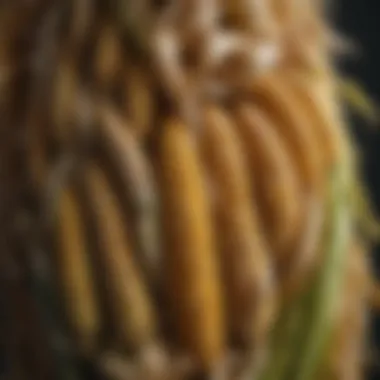
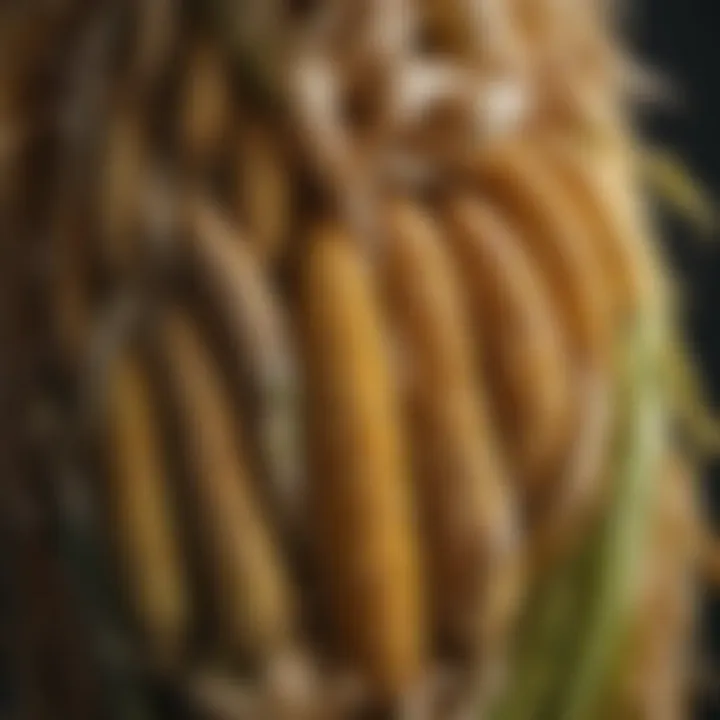
The careful integration of technology also ensures that these machines work well in different conditions. Whether dealing with wet, heavy crops or lighter ones, Calmer corn heads can adjust to optimize performance. Farmers who invest in this technology often report noticeably improved results, ultimately leading to greater yields and better management of resources.
"Technological advancements in equipment design have transformed the harvesting landscape, making it smarter, faster, and more efficient."
Key Components of Calmer Corn Heads
The effectiveness of corn harvesting is largely determined by the components of the corn head. Key components of Calmer corn heads significantly impact efficiency, productivity, and maintenance practices in the field. Understanding these parts is essential for farmers and agronomists aiming to enhance their operations. Each component plays a role in the overall performance of the harvesting process, making it critical to grasp their functions and optimizations.
Gathering Chain Assemblies
Gathering chain assemblies are pivotal in the corn head's ability to gather crops without loss. They consist of chains that move in a continuous loop, capturing corn stalks for an efficient transfer to the feeding mechanism. The design of these assemblies impacts how well they grab and convey the corn. A properly functioning gathering chain mechanism reduces kernel loss and enhances the harvesting speed.
Some benefits include:
- Efficiency: They enable quick collection of crops, which is beneficial during peak harvest times.
- Reduced Waste: Effective gathering minimizes unharvested corn, maximizing yield per acre.
- Adaptability: The assembly can be fitted and adjusted for various terrains and crop conditions, making them versatile.
Header and Snout Design
The header and snout design are crucial in directing and guiding the corn plants into the cutting components of the corn head. The design features should facilitate a smooth flow of the plants toward the gathering chains. The snouts can vary in width and angle, impacting how well they pick up corn without damaging the plants.
Key considerations include:
- Material: The quality of materials used affects the durability and performance over seasons.
- Aerodynamics: A streamlined design reduces drag, which leads to smoother operation and reduces fuel consumption on the machinery.
- Adjustability: Headers that can be adjusted provide better ground contact, leading to improved performance.
Roller and Knives Mechanism
The roller and knives mechanism ensures that the corn is cut efficiently and effectively. This system features sharp blades and rollers that work in tandem to slice the stalks cleanly. The performance of this mechanism is vital for the overall efficiency of the harvest.
Some important aspects are:
- Cutting Efficiency: A sharp knife ensures minimal stress on the plants, enabling healthier harvest conditions.
- Durability: High-quality materials can withstand wear and tear from consistent use, contributing to lower maintenance costs.
- Precision: The alignment and spacing of the knives determine how effectively the system works to reduce losses.
Auger and Feed Systems
The auger and feed systems transport the harvested crop from the corn head to the combine, allowing for continuous operation. The auger's design grips and moves the crop towards the feeding area, where it is processed further. An effective auger design enhances the speed and consistency of crop movement.
Factors to consider include:
- Capacity: A well-designed auger can handle larger volumes, making it suitable for extensive harvesting operations.
- Consistent Flow: Augers that provide a uniform feed rate reduce jamming and ensure smooth processing.
- Maintenance: Easy access for cleaning and repairs ensures that the auger remains operational throughout the harvest.
Overall, the components of Calmer corn heads contribute significantly to their performance and longevity. Understanding these key elements can lead to better decision-making for enhanced agricultural practices.
Material and Durability Considerations
The choice of materials used in the construction of Calmer corn heads is crucial for achieving optimal performance and longevity. The components are constantly subjected to wear and tear from harsh harvesting conditions. Thus, understanding various material properties can guide manufacturers and users alike in making informed decisions.
Importance of Material Selection
Using high-quality materials ensures that each part can withstand the rigors of operations in various terrains and climates. For instance, steel is often preferred due to its strength and resistance to damage. Advanced grades of stainless steel may be used in certain components for added durability and corrosion resistance.
Material benefits include:
- Enhanced Longevity: High-quality materials can significantly prolong the lifespan of corn head parts, reducing the necessity for frequent replacements.
- Increased Efficiency: Durable components maintain their integrity under stress, which helps to ensure consistent harvesting efficiency.
- Lower Maintenance Costs: Choosing robust materials can lessen the frequency of repairs, saving farmers time and money.
Durability in Design
Durability is not solely about the material. It also involves design considerations that can mitigate stress on various components. For example, parts designed to distribute load evenly tend to show less wear. Attention to detail in the design phase can lead to a notable reduction in failure rates during harvesting operations.
Considerations for Users
When selecting a Calmer corn head, users must consider the specific materials utilized in its construction. Identifying materials can help in making predictions about performance and longevity. A thorough understanding can also guide users in effective maintenance practices that are pivotal for extending the life of their equipment.
"Durability is not just about resistance to wear; it's about how materials perform in real-world conditions and ensuring they remain reliable throughout harvest season."
Ending
Overall, the interplay between material choice and durability considerations greatly influences the function of Calmer corn heads. By prioritizing resilient materials and thoughtful designs, users can enhance their farming productivity while minimizing operational risk.
Maintenance Best Practices for Calmer Corn Heads
Proper maintenance of Calmer corn heads is essential for achieving optimal harvesting efficiency. Regularly maintained equipment lasts longer, operates better, and helps prevent unforeseen failures. Maintenance practices also help in reducing downtime during critical harvesting periods.


Routine Inspections
Routine inspections are the foundation of effective maintenance. Farmers should conduct a thorough examination of the corn head before and after each harvesting season. This process includes checking for wear and tear on key components such as the gathering chains, augers, and knives. Identifying issues early can save costs on more serious repairs.
Here are some inspection tips:
- Visual Checks: Look for cracks, bends, or any visible damage on the corn head.
- Functionality Tests: Ensure that all moving parts work smoothly without unnecessary resistance.
- Alignment: Verify that all components are aligned to avoid uneven wear.
- Torque Settings: Confirm that all bolts and connections are properly torqued to specifications.
Regular inspections foster a proactive mindset towards maintenance, preventing problems that could lead to inefficient harvesting.
Lubrication and Cleaning
Lubrication is crucial in maintaining the moving parts of Calmer corn heads. Proper lubrication minimizes friction and wear, extending the life of components significantly. Each part has specific lubrication points, and following the manufacturer’s recommendations is vital.
Cleaning is equally important. Harvesting corn can expose the equipment to dust, debris, and plant residue. Regular cleaning ensures that nothing interferes with the machine's performance. Farmers should follow these steps:
- Daily Cleaning: Remove any debris stuck to the corn head after each use.
- Lubricate Moving Parts: Apply lubricant to all specified areas per the maintenance manual to ensure smooth operation.
- Inspect Filters and Screens: Ensure they are free from clogs to maintain optimal performance.
"Efficient maintenance can drastically affect harvest yield and overall operation success."
By prioritizing lubrication and cleaning, farmers can ensure their Calmer corn heads remain in optimal working condition, ultimately enhancing harvesting efficiency.
Selecting the Right Calmer Corn Head
Choosing the correct Calmer corn head is critical for ensuring effective and efficient harvesting operations. This component significantly influences the overall performance of the harvesting system, affecting not just yield but also the cost of operation. Different models offer distinct advantages, and understanding these nuances can help farmers make well-informed decisions that align with their specific needs.
Size and Compatibility
Size and compatibility are paramount when selecting a Calmer corn head. Each model has various sizes that cater to different machinery. One must ensure that the corn head fits well with their harvester to avoid performance issues. A mismatch can lead to operational inefficiencies and unnecessary wear and tear on equipment.
- Experimental Compatibility: Before investing in equipment, conduct research on the brand of your harvester and the specific Calmer corn head model. It is crucial to ascertain compatibility as it determines ease of use and functionality.
- Field Conditions: Consider the average row spacing and field size. Calmer offers a range of sizes that can adapt to irregular field conditions and narrow lanes. This can lead to more effective harvesting, minimizing downtime.
- Weight Considerations: Heaviness of the corn head should be factored into the choice. Complex field dynamics might need a lighter model to ensure fluid movement across terrains.
Cost vs. Efficiency Analysis
In any investment decision, a cost vs. efficiency analysis is essential. A cheaper corn head may seem appealing; however, it is important to assess how well it performs over the long haul.
- Initial Investment: Calmer corn heads can be a significant initial investment. However, their durability often leads to lower long-term costs compared to inferior alternatives.
- Operating Costs: Consider the efficiency of the corn head in terms of fuel usage and maintenance requirements. A more efficient design can streamline operations, reducing overall costs.
- Impact on Yield: Evaluate the potential increase in yield as a result of using a high-quality Calmer corn head. Enhanced efficiency often translates to better harvest output, which can offset initial costs and lead to an overall profitable investment.
"Selecting the right corn head is not just about immediate needs but also involves anticipating future demands and conditions."
In summation, making a calculated decision on selecting the right Calmer corn head requires careful consideration of both size and compatibility with equipment, as well as a thorough cost versus efficiency evaluation. By addressing these aspects, farmers can enhance their harvesting efficiency and productivity.
Enhancements in Calmer Corn Head Design
The design of Calmer corn heads continues to evolve, reflecting advancements in agricultural technology. Enhancements play a vital role in addressing the ever-increasing demands of efficiency, productivity, and sustainability within the field of corn harvesting. With each improvement, manufacturers focus on optimizing performance while also taking into account the longevity of components and ease of maintenance. In this section, we explore significant enhancements and their implications for farmers.
Technological Innovations
In recent years, Calmer has incorporated a range of technological innovations into its corn head designs. These include improved materials for components that endure significant wear during operation. For example, the introduction of high-strength plastics and advanced alloys has resulted in reduced weight yet enhanced durability. This not only leads to better performance but also allows for improvements in fuel efficiency during harvesting.
Automation is another key area. Modern Calmer corn heads often come equipped with sensors and control systems that optimize machine functions in real-time. These sensors can detect variables such as crop height and moisture content, allowing the corn head to adjust its settings automatically. This not only minimizes the risk of damage to crops but also maximizes yield and efficiency.
Impact of Design on Yield
The design of a corn head significantly affects the yield harvested from a field. With tailored enhancements, the ability to gather more corn while minimizing loss becomes a priority. Features such as adjustable snouts improve the ease of downed corn harvesting. This means increased effectiveness in harvesting, particularly in challenging conditions where plants may not stand tall.
In addition, improved auger designs facilitate better feeding of corn into the combine, reducing blockages and ensuring that kernels are not left behind. Effective design leads to less time spent in the field and more efficient harvest operations.
Enhanced designs also consider the flow of crop materials through the entire system. A smooth and efficient flow minimizes wear on parts and extends their lifespan, which is critical for cost-saving in maintenance. Overall, better design translates into increased productivity, which is essential in today's highly competitive agricultural landscape.
"Investing in enhancements means investing in future yield potential and operational efficiency."
In summary, enhancements in Calmer corn head design are not merely aesthetic changes but reflect a deep understanding of agricultural needs. The improvements enrich the overall harvest experience and deliver better outcomes for farmers.
Troubleshooting Common Issues
Addressing problems swiftly and effectively is vital in maintaining the efficiency of Calmer corn heads. Common issues can disrupt the harvesting process, leading to decreased productivity. Farmers and operators must be well-versed in identifying, diagnosing, and resolving these issues to optimize the use of their equipment. Understanding troubleshooting can also prolong the lifespan of the components and enhance overall performance.
Performance Degradation
Performance degradation can manifest through slower processing speeds or reduced harvesting efficiency. This may be due to several factors:
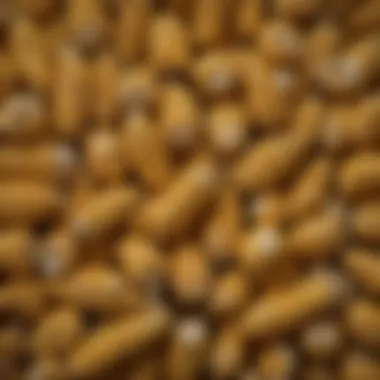
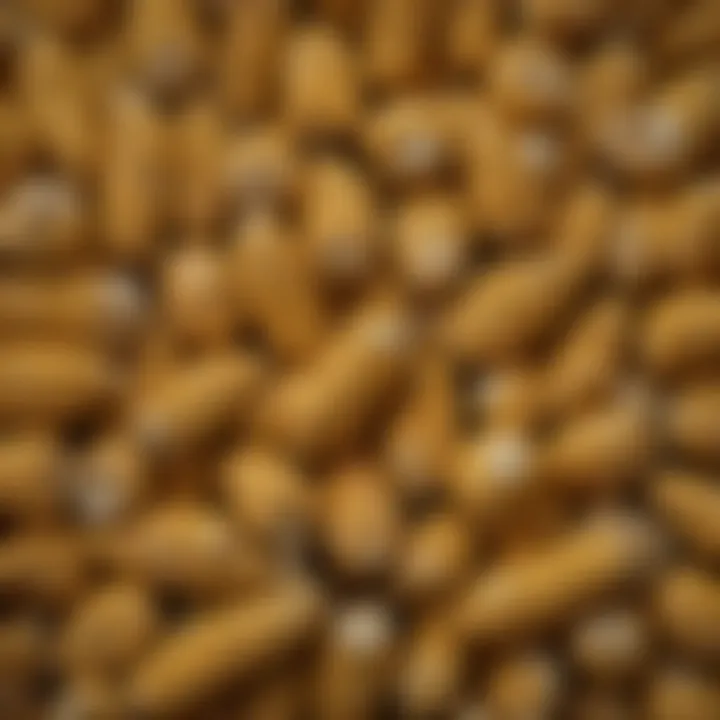
- Wear and Tear: Components like gathering chains or augers can become worn over time. Regular assessments can prevent unexpected failures.
- Improper Calibration: If the corn head isn't calibrated correctly for the specific crop conditions, it may not perform optimally. Ensuring settings are adjusted according to the crop type and conditions is crucial.
- Clogging: Debris or residue buildup can obstruct the machine's flow, causing a drop in productivity. Operators should routinely clear any obstructions.
Enhancing awareness of these factors and conducting preventative maintenance can significantly reduce performance issues.
Mechanical Failures
Mechanical failures represent a serious concern in any agricultural operation. They can result in costly downtime and repairs, affecting harvest timelines. Some common causes of mechanical failures include:
- Component Fractures: Extreme stress on parts can lead to fractures. Regular inspections are necessary to catch and address these early.
- Insufficient Lubrication: Lack of lubrication can cause friction and overheating, leading to breakdowns. Implementing a stringent lubrication schedule can mitigate such risks.
- Electrical Failures: With many modern corn heads integrating electronic controls, troubleshooting electrical components becomes essential. A failure could disrupt the entire system.
Addressing these mechanical issues promptly can save cost and prevent further complications, thus ensuring smoother harvesting operations.
"Preventative maintenance is the key to minimizing downtime and boosting overall efficiency during the harvest season."
Maintaining an informed mind about potential issues and their solutions can support smoother operations in the field.
Future Trends in Corn Head Technology
The evolution of corn harvesting technology has witnessed remarkable advancements in design and functionality. As farmers strive for improved efficiency and yield, the exploration of future trends in corn head technology becomes vital. Understanding these trends equips farmers and agronomists with insights that can significantly enhance productivity and operational effectiveness. This section delves into two key areas: the integration of automation and robotics, and the move towards sustainable practices in corn head design and use.
Automation and Robotics
Automation stands as a critical component of the future for corn head technology. The integration of automated systems not only enhances the precision of harvesting but also reduces the physical and mental burden on operators. Today, many farms are adopting machinery fitted with advanced sensors and tracking systems. These innovations can monitor crop conditions and optimize performance in real-time.
The benefits of automation include:
- Increased Efficiency: Automated corn heads can operate at optimal speeds and angles, leading to less yield loss and more effective harvests.
- Labor Savings: With fewer operators needed, farms can significantly save on labor costs while reallocating them to other vital tasks.
- Data Collection: Automated systems often come equipped with analytical tools that help in data collection, which is crucial for decision-making in future planting seasons.
As technology progresses, the potential for robotics in harvesting corn grows. Automated harvesters equipped with robotic arms can assist in picking up corn with precision, reducing damage to crops. This reflects a broader industry trend towards increased mechanization and efficiency.
Sustainable Practices in Design and Use
Sustainability is increasingly becoming a priority in agricultural practices. The design and use of corn head technology are not exempt from this trend. Manufacturers are now focusing on creating parts that are not only effective but also environmentally friendly. This includes using materials that are sustainable and production methods that minimize carbon footprints.
Key considerations in sustainable practices include:
- Material Selection: Using biodegradable or recycled materials in the construction of corn heads can reduce ecological impact.
- Energy Efficiency: Engineers are designing corn heads that require less energy, leading to reduced fuel consumption during harvesting.
- Innovative Design: Developing corn heads that optimize the flow of harvested corn reduces spillage and waste, allowing for sustainable yield maximization.
Emphasizing sustainability not only addresses environmental concerns but also responds to consumer demand for more responsible farming practices. As markets continue to evolve, emphasis on sustainability will drive further innovation in corn head technology.
"Incorporating automation and sustainability into corn head technology not only enhances performance but also addresses the pressing need for environmentally responsible agriculture."
Through understanding these trends, farmers can make better decisions that align with both efficiency goals and the imperatives of sustainable agriculture.
Case Studies: Successful Calmer Corn Head Usage
Case studies provide valuable insights into the practical applications of Calmer corn heads in real-world agricultural settings. Exploring these examples allows farmers to understand how specific components of the corn head contribute to enhanced harvesting efficiency and productivity.
Importance of Case Studies
The relevance of case studies lies in their ability to illustrate concrete outcomes and benefits realized through the implementation of Calmer corn head technology. Through detailed examination, it becomes clear how integrated parts work together to optimize harvesting processes. Considering actual examples helps in making informed decisions regarding purchases and usage.
Additionally, these case studies can reveal best practices, allowing farmers to leverage the successes of others to improve their own operations.
Elements of Successful Usage
- Impact on Yield: Many farms have reported increased yields after switching to Calmer corn heads, mainly due to superior gathering efficiency and reduced kernel loss. Farmers from regions like Iowa have shared their experiences of improved grain quality as a direct effect of using these corn heads.
- Operational Efficiency: In various cases, users observed significant time savings. A farmer in Nebraska noted that their harvesting time was reduced by up to 20% after adopting Calmer technology. This saved time can allow for quicker harvesting and reallocation of labor to other necessary tasks on the farm.
- Maintenance and Reliability: Several case studies highlighted the durability of Calmer corn head parts, which led to lower maintenance costs. For instance, a notable grain producer reported fewer mechanical breakdowns and an easy-to-maintain structure, allowing for smooth operational flow throughout the harvesting season.
- Cost-Effectiveness: Many users did a cost-benefit analysis after implementation. They found that although initial investments might be higher, the long-term savings and productivity gains justified the expenses. A farmer shared that the investment in Calmer parts paid off in just two seasons due to increased yields.
Considerations on Implementation
While there are numerous benefits documented in case studies, it is essential for potential users to consider certain aspects:
- Compatibility: Before purchasing, confirming that the corn head is compatible with existing equipment is crucial.
- Field Conditions: Farmers need to evaluate the specific conditions of their fields, as varying soil types and layouts can affect performance.
- Training on Use and Maintenance: Adequate training for operators is vital to maximize the benefits of Calmer corn heads. Understanding the mechanics can prevent operational inefficiencies.
The End: The Role of Calmer Corn Head Parts in Modern Agriculture
In the landscape of modern agriculture, Calmer corn head parts have emerged as fundamental components for efficient harvesting. Their design and functionality directly influence the overall productivity of corn harvesting operations. By understanding the specific roles of these parts, farmers can make educated choices that lead to improved efficiency and crop yields.
The key advantage of utilizing quality parts like gathering chains, headers, and rollers lies in their ability to enhance material handling during the harvest process. Each component is engineered to work in harmony, ensuring that the corn is collected and processed quickly and effectively. This not only maximizes the quantity of crop harvested but also minimizes waste.
Important elements to consider include:
- Durability and material selection: Choosing high-quality materials can lead to longer-lasting parts, reducing the frequency of replacements and downtime during harvest.
- Maintenance protocols: Regular inspections and maintenance can prevent mechanical failures, keeping the harvesting process smooth and uninterrupted.
- Compatibility with equipment: Selecting the right Calmer corn head that works seamlessly with existing harvesting equipment can significantly improve operational efficiency.
"Investing in the right corn head parts is investing in the future of your agricultural output."
Farmers who appreciate these factors will find themselves not only meeting current demands but also adapting to future challenges in agriculture. As technology advances, embracing innovation in corn head design and maintenance practices becomes increasingly critical.
In summary, the role of Calmer corn head parts extends far beyond mere functionality. They are essential tools that empower farmers to optimize their harvests, drive greater productivity, and ultimately secure their positions within the competitive agricultural sector.



